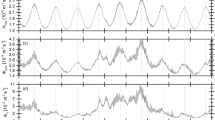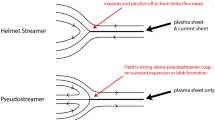Abstract
A comparison of temporal profiles of low-energy ion intensity and magnetic field magnitude in different periods of solar activity in the outer heliosphere is carried out using the data of the Voyager 1 and Voyager 2 spacecraft. It is shown that temporal, spectral, and statistical characteristics of particle fluxes and magnetic field in the heliospheric regions before and after the terminal shock in 2002–2008 had similar dynamics in different hemispheres. This similarity allowed one to assume that, in the region of the inner heliospheric boundary, a quasistable spatial structure existed moving together with the terminal shock in accordance with the solar wind pressure, as well as, probably, under the action of the interstellar medium. It was revealed that the spatial dimensions of most details of this structure are less on Voyager 2, which, probably, is due to variation of the solar activity level, difference in latitude of spacecraft disposition, and also the influence of the interstellar magnetic field.
Similar content being viewed by others
References
Hill, M.E., Hamilton, D.C., Decker, R.B., and Krimigis, S.M., Sustained Energetic Particle Intensity Enhancements at Voyager 1 Beginning in 2002, Proc. 28th ICRC, 2003, p. 3893.
Zeldovich, M.A., Dmitriev, A.V., Kecskemety, K., et al., On the Possible Detection of the Outer Heliosphere Boundary Signatures in Accelerated Ions Seen by Voyager 1 Beginning from July 2002, Proc. 28th ICRC, 2003, p. 3785.
Zeldovich, M.A., Veselovsky, I.S., Dmitriev, A.V., and Logachev, Yu.I., Possible Discovery of Indications of Approach of the Voyager 1 Spacecraft to the Heliosphere Boundaries, Astron. Vestn., 2003, vol. 37, no. 5, p. 459.
Veselovsky, I.S., Logachev, Yu.I., Kecskemety, K., et al., On the Possible Acceleration and Temporary Confinement of Energetic Ions in the Distant Heliosphere, Adv. Space Res., 2006, vol. 37, p. 1433.
Veselovsky, I.S., Zeldovich, M.A., Kecskemety, K., and Logachev, Yu.I., Fluxes of Protons with Energies from Fractions to Tens of MeV in the Distant Heliosphere and near Its Boundaries, Izv. Ros. Akad. Nauk, Ser. Fiz., 2005, vol. 69, no. 6, p. 842.
Krimigis, S.M., Armstrong, T.P., Axford, W.I., et al., The Low Energy Charged Particle (LECP) Experiment on the Voyager Spacecraft, Space Sci. Rev., 1977, vol. 21, p. 329.
Behannon, K.W., Acuña, M.H., Burlaga, L.F., et al., Magnetic Field Experiment for Voyagers 1 and 2, Space Sci. Rev., 1977, vol. 21, p. 235.
Izmodenov, V.V., Alexashov, D.B., and Myasnikov, A.V., Direction of the Interstellar H Atom Inflow in the Heliosphere: Role of the Interstellar Magnetic Field, Astron. Astrophys., 2005, vol. 437, pp. L35–L38.
Veselovsky, I.S. and Zeldovich, M.A., Statistical Properties of the Fluxes of Energetic Ions and Solar Wind in the Region of Intersection of Shock Fronts in the Distant Heliosphere, Kosm. Issled., 2008, vol. 46, no. 1, pp. 10–16. [Cosmic Research, 2008, vol. 46, no. 1, pp. 8–14].
Ness, N.F., Burlaga, L.F., Acuña, M.H., et al., Studies of the Termination Shock and Heliosheath at > 92 AU: Voyager 1 Magnetic Field Measurements, Proc. 29th ICRC, 2005.
Burlaga, L.F., Ness, N.F., Acuña, M.H., et al., Crossing the Termination Shock into the Heliosheath: Magnetic Fields, Science, 2005, vol. 309, p. 2027.
Decker, R.B., Krimigis, S.M., Roelof, E.C., et al., Voyager 1 in the Foreshock, Termination Shock, and Heliosheath, Science, 2005, vol. 309, p. 2020.
Ko-ta, J., Anomalous Cosmic Rays at a Blunt Termination Shock, Proc. 30th ICRC, 2007, p. 231.
Cummings, A.C. and Stone, E.C., Possible Role of Transients on the Energy Spectra of Energetic Particles at the Solar Wind Termination Shock, Proc. 30th ICRC, 2007, p. 1118.
Burlaga, L.F., Ness, N.F., and Acuña, M.H., Magnetic Field Fluctuations and Temperature in the Heliosheath, Astrophys. J., 2009, vol. 691, p. L82.
Burlaga, L.F., Ness, N.F., Acuña, M.H., et al., Observations of the Heliosheath and Solar Wind near the Termination Shock by Voyager 2, Astrophys. J., 2009, vol. 692, p. 1125.
Baranov, V.B. and Malama, Y.G., Model of the Solar Wind Interaction with the Local Interstellar Medium: Numerical Solution of Self-Consistent Problem, J. Geophys. Res., 1993, vol. 98, p. 15157.
Author information
Authors and Affiliations
Additional information
Original Russian Text ©. I.S. Veselovsky, M.A. Zeldovich, 2010, published in Kosmicheskie Issledovaniya, 2010, Vol. 48, No. 2, pp. 131–140.
Rights and permissions
About this article
Cite this article
Veselovsky, I.S., Zeldovich, M.A. Low-energy ion fluxes and magnetic field on the inner boundary of the heliosphere. Cosmic Res 48, 129–138 (2010). https://doi.org/10.1134/S0010952510020024
Received:
Published:
Issue Date:
DOI: https://doi.org/10.1134/S0010952510020024




